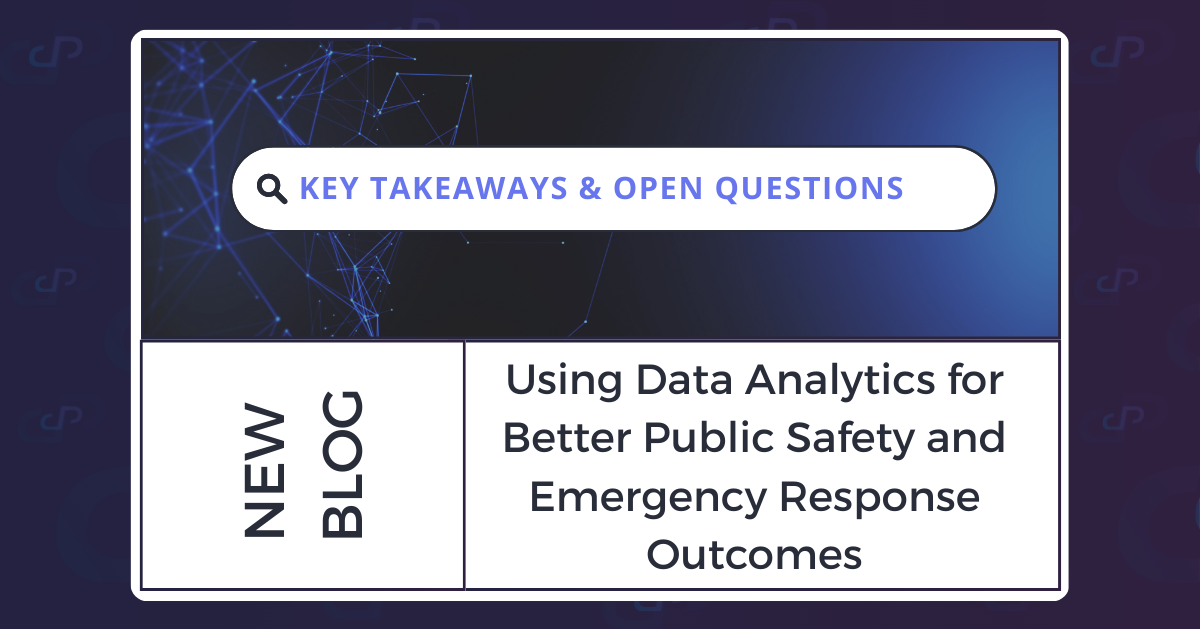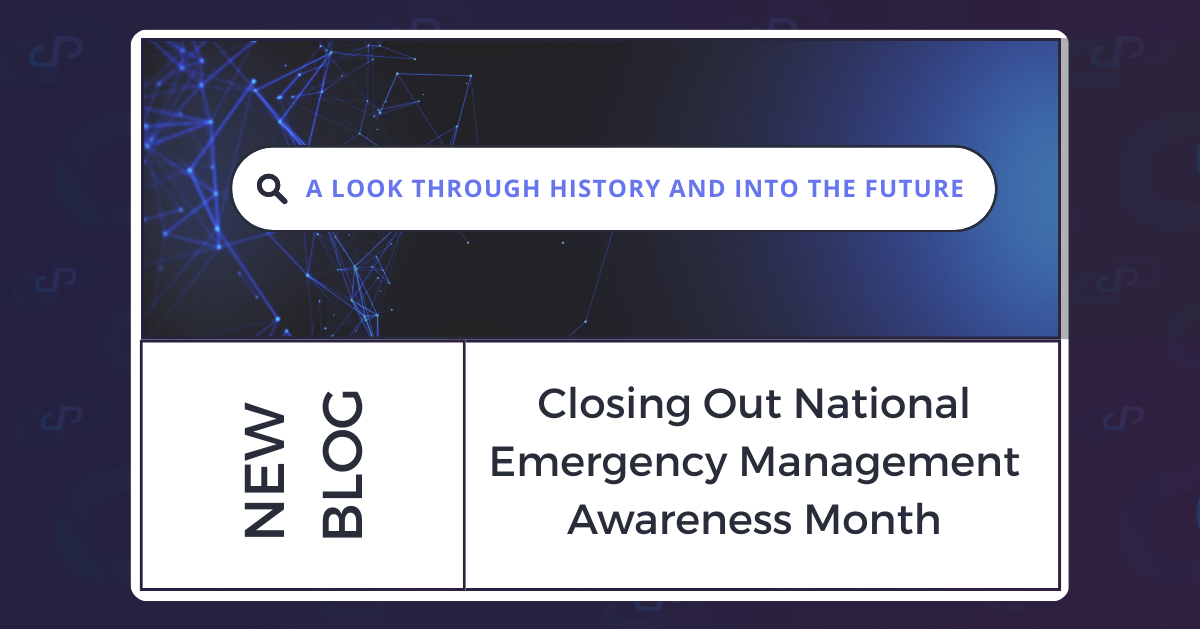Data Analytics in Public Safety & Emergency Response | Key Takeaways
AuthorPRATUS Team

Using Data Analytics for Better Public Safety and Emergency Response Outcomes: Key Takeaways & Open Questions
In an era where data drives decisions, public safety and emergency management professionals must implement solutions that provide the right data at the right time to support live saving decisions. On July 22, 2025, FedInsider hosted a compelling webinar titled “Using Data Analytics for Better Public Safety and Emergency Response Outcomes,” the first in a three-part series on cloud-based public safety solutions. The session brought together top emergency management leaders to explore how data, AI, and cloud computing are reshaping how communities prepare for and respond to crises.
Moderated by FedInsider’s John Breeden, the panel featured:
- Sean Griffin, CEO and Co-founder of Disaster Tech
- Raymond Riordan, Director of Emergency Management, City of San Jose, CA
- Brendan McCluskey, Director of Emergency Management, King County, WA

Each speaker brought deep experience and real-world examples of how data is being used to improve outcomes for first responders and the communities they serve in Washington and California.
If you missed the live webinar, click the link to sign up, watch the webinar, and gain continuing education credits here.
What Matters Most in Data-Driven Emergency Response?
Attendees included a diverse mix of professionals, from federal, state, and local emergency managers to ER clinicians. Here are some of the key takeaways:
- “Exciting discussion. Very informative. Nicely done.”
- “Love listening to experts talk about data. More please.”
- "I loved that the discussion was practically applied to the real world. Very useful.”

When asked, “What else should we be thinking about when it comes to using data analytics for better outcomes?”, attendees raised critical points:
- “Consistency and reliability of the data source.”
- “Accuracy of data, from tons of data available.”
- “Data Quality.”
- “Considering the ethics of utilizing AI when there isn't currently a US regulatory framework to operate within.”
- “Timeliness of the data.”
PRATUS™ provides a platform that delivers quality, timely, and reliable data for public safety and emergency management decisions.
As Roger Coleman, President and co-founder of Disaster Tech, emphasized: “PRATUS is built for crisis response across civilian, federal, commercial, DoD, and NGO sectors. It’s not just about data... it’s about delivering real-time, automated situation reports and impact assessments that support operational coordination, not just passive analysis.”
Sean Griffin, CEO and co-founder, further highlighted: “As discussed during the webinar, data and cloud solutions for emergency management must be resilient, reliable, and scalable...this is why we have partnered with Microsoft to advance their hyper scale, resilient cloud technologies to provide emergency management professional with tools that are reliable when most needed to save lives and protect their communities.”
Continue reading or click the links below to see how these critical questions are addressed with PRATUS.
- How PRATUS Leverages AI to Enable Data-Driven Decision-Making
- Scalable & Built for Cross-Sector Collaboration
- Navigating Ethical AI in Public Safety & Emergency Management
- How PRATUS Leads with Transparency
How PRATUS Leverages AI to Enable Data-Driven Decision-Making
Today, public safety and emergency management face unprecedented challenges. From severe disasters like wildfires, hurricanes, and floods, emergency managers require an all-hazards solution that can fit to scale for any type of crisis situation.
Disaster Tech’s PRATUS is an AI-powered, software-as-a-service (SaaS) platform purpose-built to meet the evolving demands of modern emergency management. As a premier Microsoft partner, PRATUS integrates directly into the Microsoft 365 ecosystem, including Teams and Copilot, so users can collaborate within the tools they already use every day.
One of the biggest hurdles in emergency management is the reliance on data that’s already outdated by the time it hits the decision-maker’s desk. Manually synthesizing large volumes of data delays response decisions translating in deadly or costly results. PRATUS AI-driven engine, DisasterGPT™, rapidly analyzes millions to billions of data points in seconds to provide timely, accurate analysis to support decision making with your defined planning or decision cycle.
A standout feature is AutoSITREPs (automated situation reports), which organize and analyze data from open sources, proprietary third party data, internal documents, and company or agency data into a unified report. These reports offer immediate understanding of the situation to assess requirements for mission assignments and resource allocation.

Because PRATUS is natively embedded in Microsoft Teams, collaboration across departments, jurisdictions, and organizations is seamless. Simply add users to your Teams tenant, and all communication, coordination, and decision-making happens within a unified interface.
Scalable & Built for Cross-Sector Collaboration
Built on hyperscale cloud infrastructure, PRATUS is engineered to support large-scale coordination, whether for 100 users or 100,000+. PRATUS is also input-agnostic, allowing users to seamlessly ingest and operationalize data from virtually any source: proprietary systems, government feeds, legacy programs of record, or open-source platforms.
Because PRATUS supports open-source formats, it preserves user data ownership and promotes interoperability across sectors. This makes it easy to collaborate with a wide range of stakeholders, including:
- Government agencies at all levels
- Commercial partners and infrastructure providers
- Civilian groups such as out-of-state utility crews, volunteer boat clubs, and local nonprofits
Whether you're coordinating across jurisdictions or integrating diverse data streams, PRATUS ensures that everyone operates from a shared, secure, and real-time common operating picture.
Navigating Ethical AI in Public Safety & Emergency Management
AI in public safety and emergency management is still a grey zone in the U.S., with no clear regulatory framework. So, what does ethical AI use really look like?
Over the past few years, the U.S. Government has offered some guidance:
- 2022: The White House released the Blueprint for an AI Bill of Rights, outlining five principles:
- Safe & Effective Systems: Built with diverse input to avoid harm.
- Fair Algorithms: Designed to promote equity.
- Data Privacy: Users should control their personal data.
- Transparency: Clear notice when AI is in use.
- Human Alternatives: Opt-out options and access to human support.
- 2023: An Executive Order introduced standards for safe, secure, and equitable AI deployment, emphasizing testing, privacy, and public trust.
- DHS Framework: The Department of Homeland Security set guidelines for responsible use of AI in disaster response, cybersecurity, and infrastructure protection, establishing four key principles:
- Lawful and Mission-Appropriate: AI must follow laws and protect rights and privacy.
- Mission-Enhancing: AI should clearly support DHS operations and goals.
- Safe, Secure, and Responsible: AI must be tested, secure, and designed to minimize bias.
- Trustworthy: AI should be explainable and produce clear outputs.
- Human-Centered: AI must account for its impact on people and be shaped by continuous user and community feedback.
How PRATUS Leads with Transparency
PRATUS is designed with ethical AI and data protection at its core, giving public safety and emergency management teams the confidence to act quickly without compromising privacy or control.
- Built for Transparency: Every AI-generated insight is explainable, editable, and traceable
- Human-Led Decisions: AI supports, but never replaces, expert judgment
- Secure by Design: Microsoft 365 integration helps keeps data within your organization’s tenant
- Peace of Mind: Your data stays protected, confidential, and under your control
Final Thoughts
The July 22 webinar underscored a powerful truth: data analytics is no longer a luxury in public safety and emergency management; it’s a necessity.
PRATUS is unlike existing tools. It helps agencies move from reactive to proactive, from fragmented to unified, and from stale to real-time. Whether you’re a state emergency management, a hospital clinician, or a volunteer coordinator, the ability to act on reliable, ethical, and timely data is what defines success in today’s landscape.
Key Takeaways:
- Hyper scale cloud with data analytics reshapes how agencies prepare, respond, and recover
- Ethical AI must be transparent, privacy-conscious, and human-centered
- PRATUS™ offers a scalable, interoperable, and secure solution for cross-sector collaboration
As we move forward, the challenge is not just technological; it’s cultural. It’s about building trust, fostering collaboration, and ensuring that every decision made in a crisis is informed, inclusive, and impactful.
Want to see how PRATUS transforms emergency management with real-time data? Let’s continue the conversation. Schedule a demo today to explore how PRATUS can work for your team.




